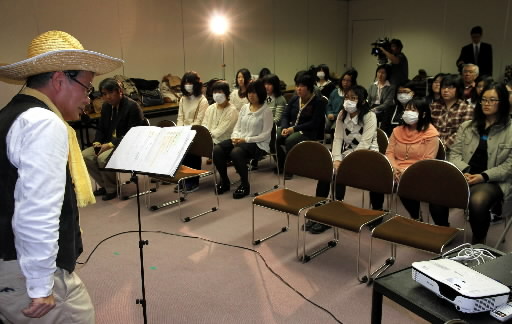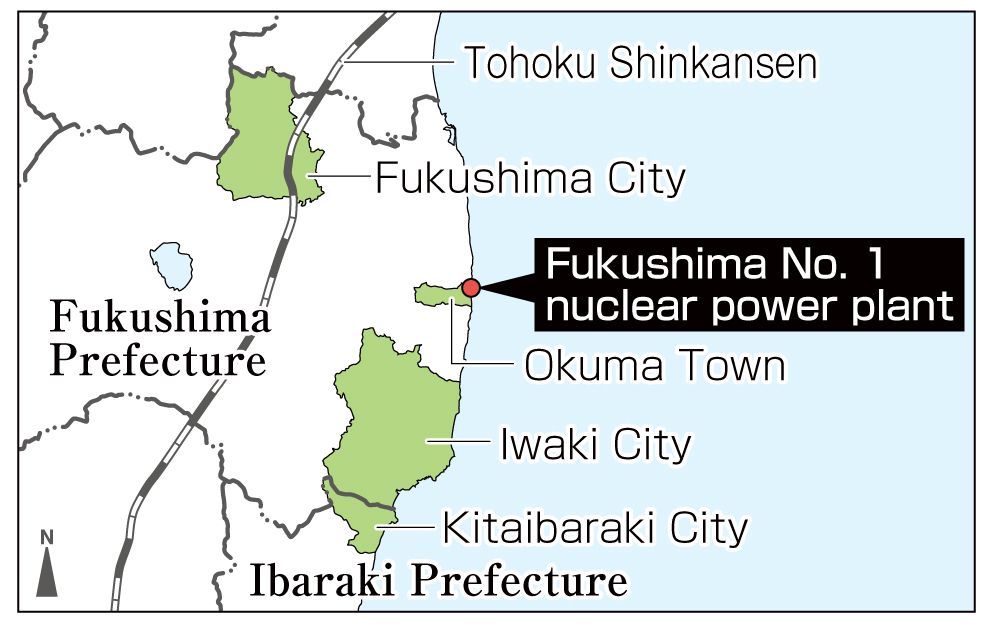Fukushima and Hiroshima: Two Years After the Great Eastern Japan Earthquake, Part 3
Mar. 21, 2013
Handing down culture: Picture story shows convey memories
by Ryutaro Inoue, Staff Writer
A young man shouted, “Grandma, run! Quick! The nuclear plant has exploded! Are you okay?”
As he flipped the panels of a “picture story show,” the performer read the lines in an urgent voice. Some members of the audience were in tears.
Nineteen first-year students from Koriyama Women’s College in Fukushima Prefecture were watching the presentation in a meeting room at the International Conference Center Hiroshima in late February.
The story is based on the personal notes made by an elderly woman who evacuated from the town of Namie, in Fukushima Prefecture, after the accident at the Fukushima No. 1 (Daiichi) nuclear power plant. The woman died last June, at the age of 84, without ever returning to her hometown. A citizens’ group called the “Machi Monogatari Seisaku Iinkai” (“Community Story Production Committee”) then based their picture story show on the woman’s experience. Before the students from Fukushima visited Hiroshima, the group was asked by the college to present their story to the students.
Afterward, Kumi Otsuka, 19, said, “I live in Fukushima Prefecture, too, but I didn’t have a clear idea of how people are living as evacuees. I’ll now think about what I can do to help.”
Since December 2011, members of the Hiroshima-based group have visited people living in temporary housing facilities five times and collected local folk tales and the evacuees’ experiences following the accident.
To date, the group has created 50 picture story shows, most of which are based on folk tales. In December 2012, they helped stage the Fukushima Picture Story Show Festival in Iwaki, Fukushima Prefecture, in cooperation with local NPOs.
Hidenobu Fukumoto, 56, the leader of the group, said, “I hope people who are forced to be away from their hometowns for a long time will continue to feel love for their towns through these picture story shows.” Mr. Fukumoto, who lives in Hatsukaichi, Hiroshima Prefecture, draws pictures for the group’s stories.
Mr. Fukumoto added, “When the atomic bomb annihilated the city and its people, Hiroshima lost numerous stories that had been handed down through the generations.” Seeing this area of kinship between Hiroshima and Fukushima, and believing that bonds are formed among people through the sharing of stories, Mr. Fukumoto is determined to maintain his support for these two places to help leave behind their cultural legacies.
Some former residents of Fukushima have started creating picture story shows, too. Mothers who grew up in the town of Okuma, where the defunct nuclear power plant is located, have begun gathering local folk tales in a quest to create 100 such shows. With no prospect of returning home, they hope this effort will help keep their towns alive in their minds.
Mr. Fukumoto is pleased that people from Fukushima also feel that stories can be used to maintain ties. The Hiroshima group, which launched this effort, will continue to support Fukushima in the creation of picture story shows.
Keywords
Picture story shows for areas affected by the Great Eastern Japan Earthquake
Two Hiroshima-based citizens’ groups, the “Machi Monogatari Seisaku Iinkai” (“Community Story Production Committee”) and Volunteer Hiroshima, launched this effort in December 2011 to help support the reconstruction of the disaster-hit areas. Members of these groups have been gathering folk tales and personal anecdotes from the Tohoku region while interviewing evacuees about their experiences of living in temporary housing. They seek to create 100 picture story shows in three years. Currently, around 30 people are involved in this project.
(Originally published on March 6, 2013)
by Ryutaro Inoue, Staff Writer
A young man shouted, “Grandma, run! Quick! The nuclear plant has exploded! Are you okay?”
As he flipped the panels of a “picture story show,” the performer read the lines in an urgent voice. Some members of the audience were in tears.
Nineteen first-year students from Koriyama Women’s College in Fukushima Prefecture were watching the presentation in a meeting room at the International Conference Center Hiroshima in late February.
The story is based on the personal notes made by an elderly woman who evacuated from the town of Namie, in Fukushima Prefecture, after the accident at the Fukushima No. 1 (Daiichi) nuclear power plant. The woman died last June, at the age of 84, without ever returning to her hometown. A citizens’ group called the “Machi Monogatari Seisaku Iinkai” (“Community Story Production Committee”) then based their picture story show on the woman’s experience. Before the students from Fukushima visited Hiroshima, the group was asked by the college to present their story to the students.
Afterward, Kumi Otsuka, 19, said, “I live in Fukushima Prefecture, too, but I didn’t have a clear idea of how people are living as evacuees. I’ll now think about what I can do to help.”
Since December 2011, members of the Hiroshima-based group have visited people living in temporary housing facilities five times and collected local folk tales and the evacuees’ experiences following the accident.
To date, the group has created 50 picture story shows, most of which are based on folk tales. In December 2012, they helped stage the Fukushima Picture Story Show Festival in Iwaki, Fukushima Prefecture, in cooperation with local NPOs.
Hidenobu Fukumoto, 56, the leader of the group, said, “I hope people who are forced to be away from their hometowns for a long time will continue to feel love for their towns through these picture story shows.” Mr. Fukumoto, who lives in Hatsukaichi, Hiroshima Prefecture, draws pictures for the group’s stories.
Mr. Fukumoto added, “When the atomic bomb annihilated the city and its people, Hiroshima lost numerous stories that had been handed down through the generations.” Seeing this area of kinship between Hiroshima and Fukushima, and believing that bonds are formed among people through the sharing of stories, Mr. Fukumoto is determined to maintain his support for these two places to help leave behind their cultural legacies.
Some former residents of Fukushima have started creating picture story shows, too. Mothers who grew up in the town of Okuma, where the defunct nuclear power plant is located, have begun gathering local folk tales in a quest to create 100 such shows. With no prospect of returning home, they hope this effort will help keep their towns alive in their minds.
Mr. Fukumoto is pleased that people from Fukushima also feel that stories can be used to maintain ties. The Hiroshima group, which launched this effort, will continue to support Fukushima in the creation of picture story shows.
Keywords
Picture story shows for areas affected by the Great Eastern Japan Earthquake
Two Hiroshima-based citizens’ groups, the “Machi Monogatari Seisaku Iinkai” (“Community Story Production Committee”) and Volunteer Hiroshima, launched this effort in December 2011 to help support the reconstruction of the disaster-hit areas. Members of these groups have been gathering folk tales and personal anecdotes from the Tohoku region while interviewing evacuees about their experiences of living in temporary housing. They seek to create 100 picture story shows in three years. Currently, around 30 people are involved in this project.
(Originally published on March 6, 2013)









